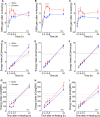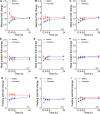The feeding microstructure of male and female mice
- PMID: 33539467
- PMCID: PMC7861458
- DOI: 10.1371/journal.pone.0246569
The feeding microstructure of male and female mice
Abstract
The feeding pattern and control of energy intake in mice housed in groups are poorly understood. Here, we determined and quantified the normal feeding microstructure of social male and female mice of the C57BL/6J genetic background fed a chow diet. Mice at 10w, 20w and 30w of age showed the expected increase in lean and fat mass, being the latter more pronounced and variable in males than in females. Under ad libitum conditions, 20w and 30w old females housed in groups showed significantly increased daily energy intake when adjusted to body weight relative to age-matched males. This was the combined result of small increases in energy intake during the nocturnal and diurnal photoperiods of the day without major changes in the circadian pattern of energy intake or spontaneous ambulatory activity. The analysis of the feeding microstructure suggests sex- and age-related contributions of meal size, meal frequency and intermeal interval to the control of energy intake under stable energy balance, but not under negative energy balance imposed by prolonged fasting. During the night, 10-20w old females ate less frequently bigger meals and spent more time eating them resulting in reduced net energy intake relative to age-matched males. In addition, male and female mice at all ages tested significantly shortened the intermeal interval during the first hours of re-feeding in response to fasting without affecting meal size. Further, 20-30w old males lengthened their intermeal interval as re-feeding time increased to reach fed-levels faster than age-matched females. Collectively, our results suggest that the physiological mechanisms controlling meal size (satiation) and the non-eating time spent between meals (satiety) during stable or negative energy balance are regulated in a sex- and age-dependent manner in social mice.
Conflict of interest statement
The authors have declared that no competing interests exist.
Figures








References
Publication types
MeSH terms
Substances
Grants and funding
LinkOut - more resources
Full Text Sources
Other Literature Sources
Research Materials

